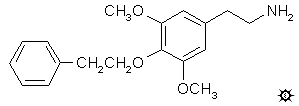
#141 PE
PHENESCALINE; 3,5-DIMETHOXY-4-PHENETHYLOXYPHENETHYLAMINE
|
| [3D .mol structure] |
A solution of 7.9 g of distilled 3,5-dimethoxy-4-phenethyloxyphenylacetonitrile in 15 mL dry THF was added to a 0 °C solution of AH prepared from a vigorously stirred solution of 4.6 g LAH in 160 ml THF which had been treated, at 0 °C with 3.6 mL 100% H2SO4 under an atmosphere of He. The gelatinaceous reaction mixture was brought to a brief reflux on the steam bath, then cooled again. It was treated with 5 mL IPA which destroyed the unreacted hydride, followed by sufficient 15% NaOH to give loose, white filterable solids. These were removed by filtration and washed with THF. The filtrate and the washes were combined and, after removal of the solvent under vacuum, there remained 7.8 g of the product as a crude base which crystallized spontaneously. Distillation of this product at 170-180 °C at 0.35 mm/Hg gave 5.1 g white solids, with a mp of 85-86 °C from hexane. This base was dissolved in 20 mL warm IPA and treated with 1.6 mL concentrated HCl. To the resulting clear solution, there was added 75 mL anhydrous Et2O which gave, after a few moments of stirring, a spontaneous crystallization of 3,5-di-methoxy-4-phenethyloxyphenethylamine hydrochloride (PE) as beautiful white crystals. The weight was 5.4 g after air drying, and the mp was 151-152 °C. Anal. (C18H24ClNO3) C,H.
DOSAGE: greater than 150 mg.
DURATION: unknown.
QUALITATIVE COMMENTS: (with 150 mg) At most, there was a bare threshold over the course of the afternoon. A vague unreal feeling, as if I had not had quite enough sleep last night. By late afternoon, even this had disappeared and I was left with an uncertainty that anything at all had occurred.
EXTENSIONS AND COMMENTARY: There is not much there, so there is not much to make commentary on. This response is called a "threshhold" effect, and cannot be used to predict with any confidence just what level (if any) would produce psychological effects.
A similar chain on the 4-position, but with one less carbon atom, deserves special comment. Rather than a phenethyloxy group, this would be benzyloxy group (which in this day and age of Chemical Abstracts purity should probably be called a phenylmethoxy group). If one were to follow the naming philosophy of Rproscaline equals P and buscaline equals BS convention, one would call it 4-benzescaline, and give it the code name BZ. The nomenclature purist would probably call the compound PM (for phenylmescaline or, more likely phenylmethoxydimethoxyphenethylamine), since the term BZ is awkward and misleading. It is a code name that has been given to a potent CNS agent known as quinuclidin-3-yl benzilate, which is a chemical and biological warfare (CBW) incapacitating agent currently being stored by the military to the extent of 20,000 pounds. And, BZ has also recently become the jargon name given to benzodiazepine receptors. They have been called the BZ-receptors.
However, let's be awkward and misleading, and call this benzyloxy-base BZ. For one thing, the three-carbon analogue 3C-BZ has already been described in its own recipe using this code. And the 4-fluoroanalogue of it, 3C-FBZ, is also mentioned there. And BZ has already been described synthetically, having been made in exactly the procedure given for escaline, except that the reduction of the nitrile was not done by catalytic hydrogenation but rather by sodium borohydride in the presence of cobalt chloride. It has been shown to be a effective serotonin agonist, and may warrant human experimentation. The serotonin activity suggests that it might be active at the same levels found for proscaline.
All of this says very little about PE. But then, there is very little to say about PE except that it may be active at very high levels, and I am not sure just how to get there safely.
| [ |
[Main Index] | [Forward |

